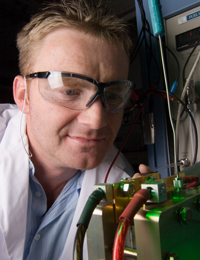Research could cut thousands off the cost of fuel cell-powered vehicles
The days of gasoline and diesel fuel are one step closer to ending thanks to new findings from the University of Houston Cullen College of Engineering. A research team with the college has made a discovery that could eliminate one of the biggest financial hurdles to the commercial introduction of fuel cell-powered vehicles.
Peter Strasser, an assistant professor of chemical and biomolecular engineering, leads the group that conducted this research. The team also includes graduate student Ratndeep Srivastava; postdoctoral researcher Prasanna Mani; and Nathan Hahn, a former UH undergraduate student who earned his B.S. degree last spring. Their findings are featured as a VIP (very important paper) abstract on the website of Angewandte Chemie, one of the world’s most prestigious chemical engineering journals, and will be published in full in an upcoming issue.
The group’s research focuses on perfecting a catalyst material for the cathode side of polymer electrolyte membrane fuel cells (PEMFCs). Like all fuel cells, PEMFCs rely on a series of chemical reactions to create electricity that can be used to power any number of devices or machines, including automobiles. PEMFCs use catalyst materials to initiate and speed these reactions, making them as efficient and effective as possible.
The cathode side of PEMFCs is where the series of reactions end, ultimately creating water, the only “exhaust” of such fuel cells. Platinum-based compounds typically serve as the catalyst materials on this side of the fuel cell.
Platinum, however, is an extremely expensive material, costing about $1,100 per ounce. A PEMFC powerful enough to operate a small two- or four-door automobile would require around 3-and-1/3-ounces of platinum costing approximately $3,600, Strasser said. That cost would naturally be passed on to the consumer, creating a significant financial barrier to the commercial success of fuel cell-powered vehicles.
“The automobile companies have been asking for a platinum-based catalyst that is four-times more efficient, and therefore four-times cheaper, than what is currently available. That’s the magic number,” said Strasser.
Strasser and his team have met and seemingly exceeded this “magic number” by creating a platinum-based catalyst that is at least four-times and up to six-times more efficient than existing catalysts. The use of such a catalyst would allow the same fuel cell-powered car to operate on about 2/3 of an ounce of platinum, cutting the cost of producing such a vehicle by almost $3,000.
The method used by Strasser is unusual in that it involves not just adding other elements to platinum, as is typical, but electrochemically removing a portion of those elements, as well. By compounding platinum with copper and cobalt, the platinum atoms in the material contract. The copper and cobalt are then removed from the surface of the catalyst compound, leaving the platinum atoms alone in a contracted state.
In this state, the bonds the platinum atoms form with oxygen atoms are weakened, allowing those bonds to react to their surroundings more easily. This frees the oxygen atoms to combine with nearby protons and electrons and form water much more quickly. The result is a catalyst material that is significantly more efficient than its predecessors.
“The strong bond that forms between oxygen and platinum at the cathode of a fuel cell is traditionally one of the most troublesome aspects of making highly efficient PEMFCs,” Strasser said. “This research outlines a way to hit the target efficiency desired by automobile manufacturers. It could literally end up cutting thousands of dollars off the price of a fuel cell-powered vehicle.”
This research is supported by more than $1.5 million in grants from the Department of Energy, National Science Foundation, General Motors, NASA through the Houston Advanced Research Center, the American Chemical Society Petroleum Research Fund and internal university grants.
